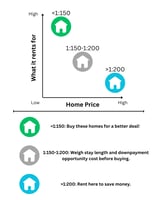Buying a home is a team effort, and your vendors (inspectors, title companies, loan originators,...
The Savvy Factor Framework: navigating the many factors of home buying
Buying a home is generally one of the biggest financial decisions you'll make, and choosing the right location plays a huge part of that in your satisfaction with that decision. Determining what makes up a 'good' location can be overwhelming, with factors ranging from crime rates and school quality to proximity to work and characteristics of the neighbors. A factor is any characteristic of a neighborhood that influences your decision to buy a home there, whether it's personal preferences like community feel or universally desirable attributes like safety and affordability. But don't worry! We've got a handy framework to help you weigh the pros and cons and make a choice that feels right for you.
Overview
Our framework is built on two simple questions: How valuable is a factor to you personally? And how valuable is it to the market? By answering these, you can categorize each factor into one of four quadrants:

- High Value to You, High Value to Market (HH) - Balance
- High Value to You, Low Value to Market (HL) - Reap
- Low Value to You, High Value to Market (LH) - Trade
- Low Value to You, Low Value to Market (LL) - Declutter
Figuring out whether or not something is important to you is easy. Just ask yourself, if this was included in the neighborhood of a house you were considering purchasing, would you be willing to give up something significant to have it? If you'd give up something like an additional 10 minutes of commute time or another $150 on your mortgage payment, then it's important to you. If the answer is no, you wouldn't be willing to give up something like that, then it's probably not important.
Figuring out if it's important to the market can be a little bit trickier from your perspective. Basically, you have to ask the same question but put yourself in the shoes of the average home buyer leaving your particular preferences aside. Ideally, you want to use data to determine which factors are associated with increased willingness to pay for housing. There are some general trends, but these vary from market to market; if that sounds complicated or tedious, SettleSavvy has both experience and data to compute this for you.
Let's break down each of these quadrants with some examples and tips.
Low to you, Low to market - Declutter
This is a good bucket for factors that might be interesting but probably won't influence most people's (including yours) purchasing decision. There are thousands of data points you could potentially examine but most of them don't matter enough to spend your valuable time factoring through.
Being able to put factors in this bucket has neutral value. It can help you put your analytical focus on more important things but having a lot of factors in this bucket is not going to do much to get you the few factors you really care about.
These factors should generally be removed from the analysis or carry a very low weight. For example, when I was buying my first home, I was really interested in the number of military families living near the houses I was looking at, it was a curiosity to me being in an area with a heavy military presence. When I considered it carefully, this factor wasn't going to change my home buying decision, and it wasn't going to change the average buyer either, so I dropped it from my analysis.
Low to you High to market - Trade
Factors that the average home buyer is going to place a lot of weight in, but you don't place much weight are fantastic. Ideally, you want to have this bucket loaded to the brim. These are bargaining chips; if you are willing to take a hit on them, you are likely going to be able to find some of the things that matter more to you.
For example, some buyers can take advantage of remote or hybrid work and online shopping so that proximity to work hubs, shopping centers, and metropolitan entertainment becomes much less important. These buyers can happily trade away proximity for factors that matter more to them, like safety, school ratings, or affordability.
Similarly, other buyers, either because they do not have school aged children or because they have alternative schooling arrangements, might be able to trade away school ratings for factors they care about more.
Unlike Declutter factors, Trade factors should not be left out of the analysis. They might affect the resale process, and you want to be crystal clear about what you are trading away. Instead, they should be given a low weight but placed on the map.
Hight to you, Low to market - Reap
These are factors that are important to you but not to the market. Factors that aren't important to the market can include obscure factors that usually don't matter very much (maybe the % of women in the neighborhood who are employed full time). Or polarized factors that matter but aren't widely agreed upon (politics would be the classic example).
These factors come "cheap"; you likely won't have to trade away much to get them. It can relay pay off in terms of quality of life to carefully consider what you want that the broader market might not want. These factors should be weighted heavily.
Hight to you High to market - Balance
This is the toughest bucket to deal with. Factors that are important to you are often also important to others, consequently, factors in this bucket are often strongly related. For example, most people want a safe neighborhood; most people also want an affordable house, however, it can be hard to find both of these.
There are a few things you can do to deal with this conundrum.
- Get out of the bucket
- Use 'Hygiene factors'
- Identify off diagonals
- Adjust expectations
Getting out of the bucket means you can shift Balance factors into either Reap or Trade. Shifting into Reap is simple but not often possible. Changing how the market values a factor usually means switching markets. To refer to an example above, some areas are just safe, even in the more affordable neighborhoods. Unfortunately, switching markets from something like DC to something like Provo UT is usually not an option. Still there can be significant differences in market conditions within a relatively constrained area (see Identifying off diagonals).
Shifting into Trade is not simple but it's always something you can try. In order to achieve this, you need to change how you value the factor. You might try shifting the time frame that you're considering the factors in, you can discuss it with other stakeholders (i.e. spouse or older children), and considering alternatives (i.e. proximity to parks vs. large backyard). This can be a challenging exercise, but it can help you identify some factors you're willing to compromise on and thus trade them for the factors that really matter to you.
Once you've carefully considered high-high factors and have shifted out those you can. Next you can try checking if some of these are Hygiene factors (read more about this concept here). In a nutshell, hygiene factors are those that can create dissatisfaction if they aren't met but generally won't create satisfaction if they are met in excess. For example, you probably need to have enough safety cues that you feel 'safe enough' to be comfortable, however, additional safety cues above and beyond that level will do little if anything to improve your comfort. For these factors, you can identify a minimum level and then in effect trade away the remainder of the hygiene factor for more motivational factors where having the highest possible level really matters.
Switching markets within a relatively constrained geography is also known as identifying 'off diagonals'. These are the neighborhoods that buck the trend. Crime and affordability are highly (inversely) correlated. If we to plot them on a chart we would see a diagonal line of points running from the top left to the bottom right with a few point more in the upper right and a few points more in the bottom left.

To use DC as an example, the Potomac area is very safe but comes with huge price tags, the College Park area is relatively affordable but comes with rampant crime. There are a few pockets to the north that are both low crime and relatively affordable (like Poolesville). Similarly, if you are able to shift the market as far South as Calvert County in southern Maryland, you can enjoy safety for a reasonable price tag.
Once you've tried getting out of the bucket, identifying hygiene factors, and looking at what kinds of off diagonals might be available your left with adjusting your expectations. This is where you have to make the tough calls; how does 10 more minutes of commute stack up against a letter grade of crime score. Weight the ones that matter most a little higher, and the ones that matter less a little lower. The prior exercises should give you a good idea of how these factors fit together and what you will need to sacrifice in order to maximize the things that really matter.
Conclusion
Using this framework can help make the home-buying process a little less daunting and a lot more fun. Remember to balance those universally important factors, reap the benefits of your personal preferences, trade strategically, and declutter the less important ones. This way, you'll find a neighborhood that feels as right as possible for you.
Happy house hunting! And remember, if you need a little extra guidance, SettleSavvy is here to help you navigate the complexities of finding your perfect home.




